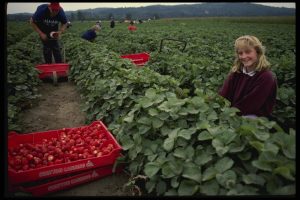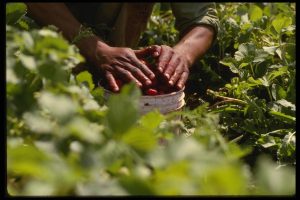Strawberries

Importance of Strawberries to Oregon
Oregon is ranked third in United States strawberry production. California and Florida are the only states that grow more. In 2020, Oregon had over 300 farms growing strawberries on 1,100 acres.1 Those farms grew 11 million pounds of berries. They were worth nearly 12 million dollars. Most of those berries are grown in Marion, Yamhill, Washington, and Clackamas counties.2
History of Strawberries
Strawberries have grown wild in Oregon throughout history. Native Americans were gathering and using the berries before commercial farming ever started in the state.
In 1847, a man named Henderson Luelling came west from Iowa on the Oregon Trail. He brought fruit trees and other plants with him in his wagon. Henderson brought many different plants that are now popular to grow in Oregon, including strawberries. The variety he brought with him was a better fit for farming than the wild berries. Japanese farmers in the Portland area were growing most of the strawberries in Oregon by the late 1800s. Hood River was also a main strawberry growing region.
The United States Department of Agriculture-Agricultural Research Service breeding program began in 1911 in Corvallis. The program still exists and has created many new varieties over the years.3
Strawberry Varieties
Hood
Hood strawberries are one of the most popular varieties in Oregon. They have been grown since 1965. They are dark red, medium-sized berries. Hoods are very sweet and juicy. They are a soft berry and have to be eaten or used quickly after picking for the best quality. Hood strawberries become ripe in early June, before many other varieties.4
Marys Peak
Marys Peak strawberries were released in 2018. They are a variety from the USDA-ARS breeding program in Corvallis. The berries are dark red and medium to large-sized. They are firm and flavorful. Marys Peak strawberries are harvested from mid-June to mid-July.
Shuksan
Shuksan berries were created in Washington in 1970. They are a large strawberry compared to other varieties. They are usually medium to firm and great for freezing, making jam, or eating fresh. They become ripe and ready to harvest from late May to mid-June.
Tillamook
Tillamook strawberries have been farmed since 2004. The berries are large, firm, and very sweet. Universities and researchers from Oregon and Washington worked together on the variety. It is named for the Tillamook tribe of Native Americans. Because the fruit are large, the variety is easy for farmers to pick. Tillamook strawberries are harvested for most of the month of June.
Life Cycle of a Strawberry
Strawberries are planted as bare root plants, not seeds. They are typically planted in the spring. Plantings won’t grow a crop to be harvested until the next summer. Strawberries are grown in raised rows. Some are lined with drip irrigation and covered with black plastic. This keeps the soil warmer and helps prevent weeds.
After they are planted, strawberries start to spread out. They have stolons, known as runners, that grow outward on the ground and put down more roots. Strawberry buds form on the plants in the fall. They go dormant over the winter and then bloom in the spring.5
Bloom and Pollination
Strawberries flowers need to be pollinated to grow fruit. They are self-fertile and can be pollinated by their own pollen. But the pollen has to get from the female part of the flower to the male part. Wind and insects, like bees, help with pollination. Once a bloom is pollinated, it can begin to grow fruit.6
Strawberry Harvest
Strawberries are ready to harvest about 4-6 weeks after they bloom and are pollinated. They are harvested by hand. Farmworkers go through the fields, selecting the berries that are ready for harvest. Fields will be harvested multiple times as berries become ripe. After being picked, the strawberries are packaged and sold. Some are for fresh eating, while others will be processed and frozen, dried, and more.

Image by Oregon ODA on Flickr
Strawberry plants are perennial, which means they can grow for multiple years. In some places, fields are harvested for one year before they are replanted. Others are grown and harvested for multiple years.

Image by Oregon ODA on Flickr
Pests and Diseases
Botrytis
Botrytis is a fungus that can cause blossom blight and fruit rot. The fungus can live in different places in strawberry fields and infect plants if weather conditions are right. Blossom blight can cause flowers to die. Fruit rot causes infected strawberries to turn brown and then become covered in fuzzy gray fungus. Sometimes the rot will not be seen until after harvest.
Spotted wing drosophila
Spotted wing drosophila (SWD) is an insect that feeds on strawberries. It is small and looks like a fruit fly. Female SWDs lay eggs inside of fruit that is growing. The larvae eat the fruit from the inside while it’s getting ripe. The fruit can look bruised and leak liquid. One female SWD can lay hundreds of eggs during her 3-4 week life.
Powdery Mildew
Powdery mildew is a fungus that can infect the young leaves of strawberry plants. It can cause the leaves to curl. The bottoms of the infected leaves are usually red and covered in a white or gray powder. The fruit can also get infected. The disease is worse when the humidity is high and there is a lot of moisture in the air.7
Thrips
Thrips are a small insect that can cause damage to strawberries. They feed on strawberry blooms. Thrips damage can be seen on brown or scarred blossoms. The damaged blossoms can grow into misshapen strawberries. They also feed on pollen and nectar. Thrips lay eggs on the plants and larvae hatch. The larvae feed on the foliage of the strawberry plants.8
Uses for Strawberries
Strawberries can be used in many different ways. One of the most popular ways to eat them is fresh. They can be frozen and blended into drinks. Strawberries are used in pies, shortcakes, and many other baked goods. Strawberry jams and other preserves are also popular.
Fun Facts About Strawberries!
- Strawberries are 91% water9
- Strawberries are grown in every state in the United States
- California grows 90% of the United States’ strawberries
- The average American eats 3.4 pounds of strawberries each year10
Vocabulary Terms
Bare Root
Dormant perennial plants that are dug up and stored without any soil around their roots.
Breeding
Selectively changing the traits of a plant.
Bud
A swelling on a plant that can grow into new parts, like leaves or a flower.
Commercial Farming
Farming with the purpose of selling a food or product.
Dormant
In a state of rest that is similar to sleep.
Drip Irrigation
A type of irrigation system that can save water by dripping water slowly to the roots of plants.
Foliage
The leaves on a plant.
Humidity
Water vapor or moisture in the air.
Larvae
An insect after it hatches from an egg and before it changes into an adult.
Perennial
A plant that lives longer than two years.
Processed
Something that has been handled or changed. This could be cutting, freezing, and more.
Self-fertile
Able to fertilize itself.
